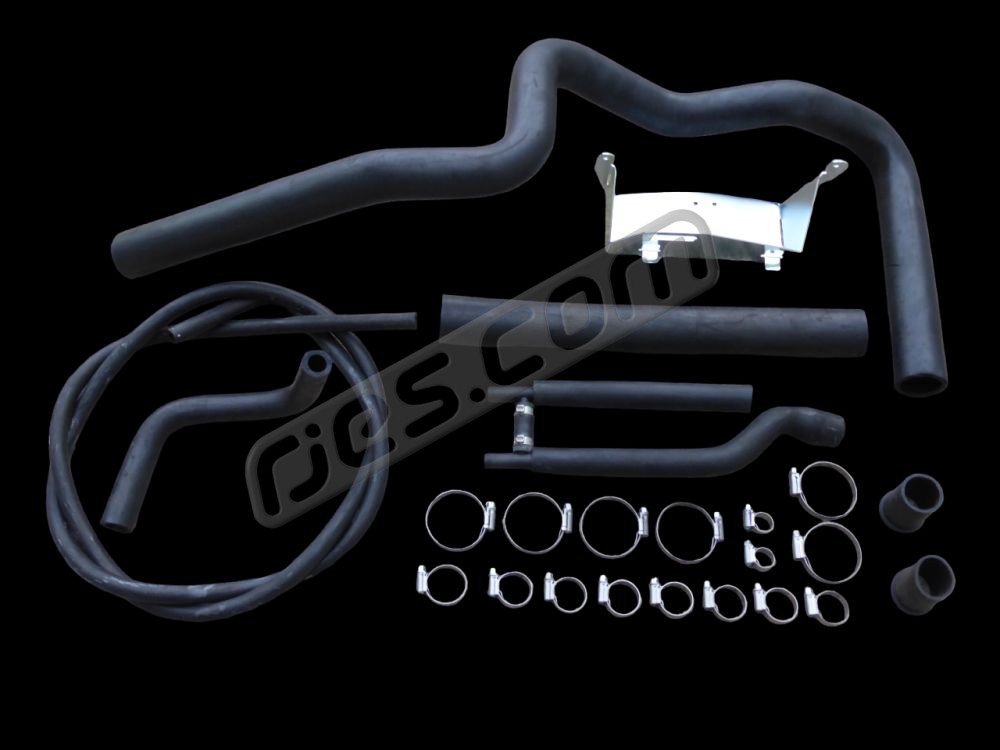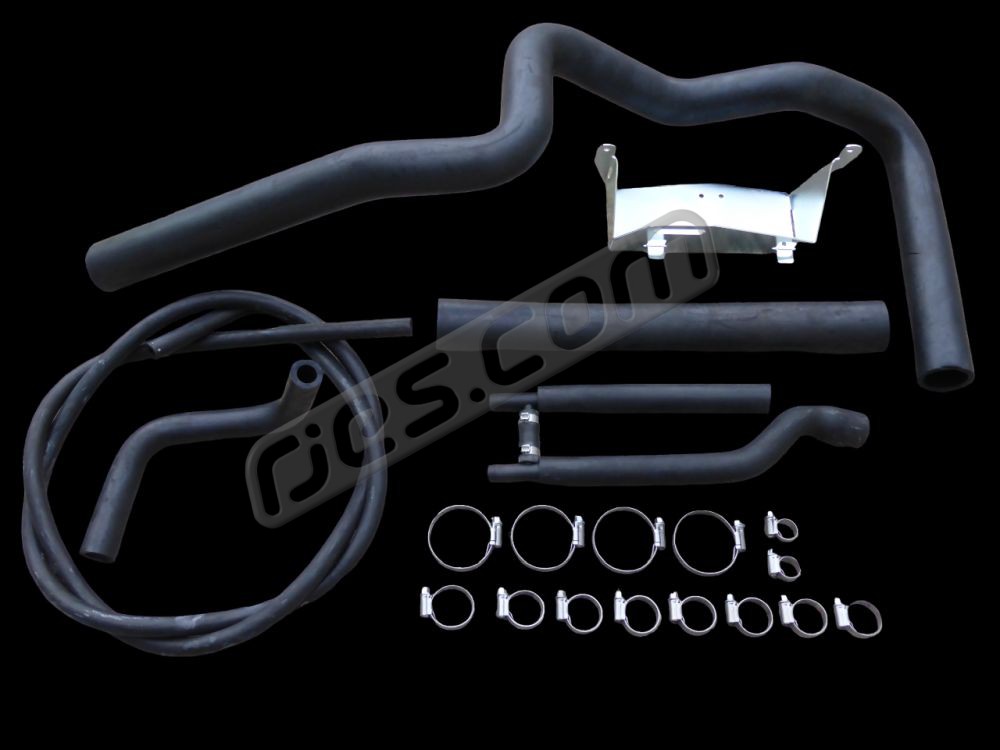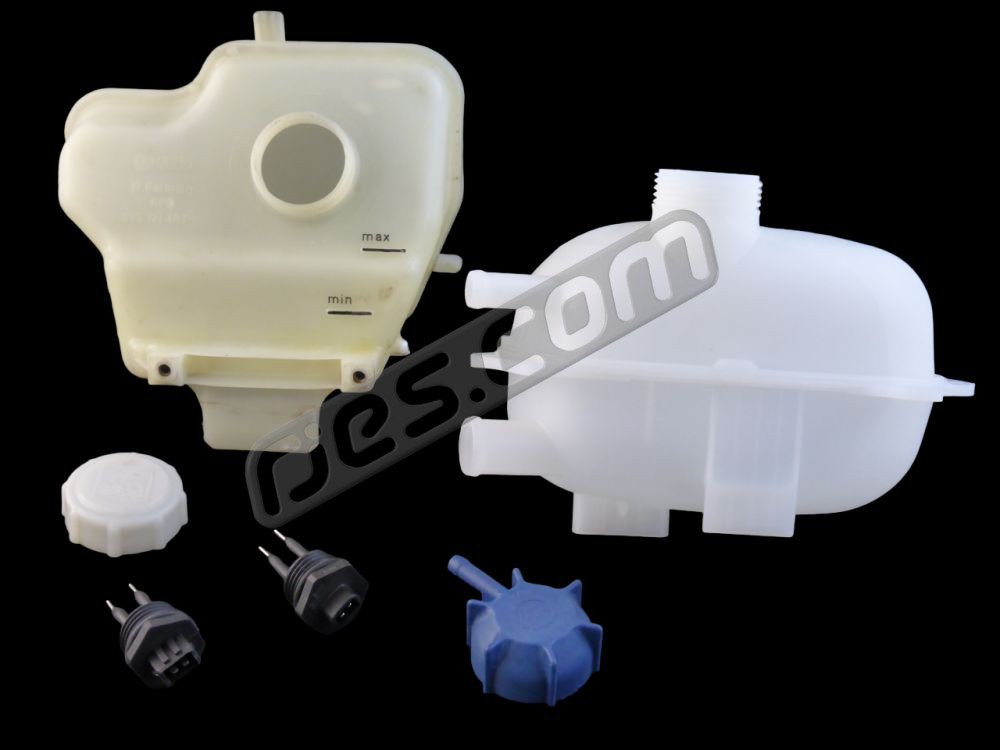We believe the cooling system that we have developed, documented on this site and which we manufacture the products for, is by far the simplest, neatest way to plumb a Subaru engine in a rear engined VW. Our kits use reinforced OEM spec hoses designed by us for the application, not hoses from another application which ‘sort of’ fit, or multiple generic hoses with joiners everywhere. Considerable effort went into designing a cooling system which is as simple and neat as possible while also being as simple to fill, bleed and understand as possible – a lot of other circuits out there have clearly been ‘designed’ by people with little to no understanding of how cooling systems work.
- Designed for climates which do not regularly go below around -10 oC (14 oF), but can be modified for colder climates where required.
- Requires the use of a coolant manifold which we have modified for fitting reversed. This is not included in the kits because a cooling plumbing kit is a product, and reversal of a coolant manifold is (usually) a service – i.e. we modify the customers own manifold. Unfortunately we do not have an infinite supply of sensibly priced Subaru coolant manifolds, so any we do have are only available to customers abroad, when sending their manifold to us to reverse could cost more than a used manifold is worth. If you have EJ series coolant manifolds which you don’t need, we’re always after certain types. Manifolds modified to reverse by others may not be suitable – if they are, they’re copying our products, as nothing like this system was available when we developed it
- Hoses manufactured to our design specifically for Subaru – VW engine conversions, to SAE engine cooling hose standards by an OEM. The same material and one of the same standards that most OEM coolant hoses are made to. No silicone rubbish.
- Exclusively uses exactly the same materials that Subaru and VW used throughout – aluminium, EPDM hoses, polypropylene and nylon. No materials unsuitable in the cooling system of an aluminium engine such as copper and stainless steel.
- Up to 41% less coolant hoses and hose clips than in some rear engined water cooled VW models. No wonder VW added a low coolant warning system after the first couple of years of water cooled model production! (the wasserboxer’s cooling system is a total mess, and there is clear evidence that adding the low coolant level warning system was an afterthought)
*manual T25 / T3 / Vanagon without rear heater or Webasto coolant heater - Retains the low coolant level warning system in the 1984 onwards models which had it – some competitors cooling systems do not
- Includes all hose clips (stainless steel)
- Designed for EJ series engined VW conversions, originally for normally aspirated applications, but there are also advantages to using this plumbing system on the turbo engines too, althouigh doing so is no as straight forward as normally aspirated
- Designed for T25 / T3 / Vanagon applications, but also quite widely used in other rear engined VW conversions where the radiator is positioned forwards of the engine (except the late Bay / T2b, which they are not suitable for because reversed coolant manifolds do not fit).
- Requires modification in automatic T25 / T3 / Vanagon models which have the oil to water transmission fluid cooler – you’ll need to add two tee pieces yourself for the heat exchanger feed and return to use these kits in such models
Coolant plumbing kit – 32mm
part no. 800-00044 Price: £122.50 GBP +VAT (£147.00)
From the introduction of water cooled models in 1981 to 1983, the T25 / T3 / Vanagon used steel coolant pipes with an outer diameter of 32mm. Includes all parts needed except the reversed coolant manifold and parts which many customers already have in their VW (header tank 025 121 403 B, Blau or genuine VW pressure regulating cap 025 121 321 B, expansion bottle 025 121 403 and cap 025 121 482):

Coolant plumbing kit – 38mm
part no. 800-00012 Price: £110.00 GBP +VAT (£132.00)
From 1984 onwards, the T25 / T3 / Vanagon models used plastic coolant pipes with an outer diameter of 38mm. Mny models which originally had the 32mm pipes (much) later had them swapped for 38mm too, as the 38mm pipes superseded the 32mm ones at some point. Includes all parts needed except the reversed coolant manifold and parts which many customers already have in their VW (header tank 025 121 403 B, Blau or genuine VW pressure regulating cap 025 121 321 B, expansion bottle 025 121 403 and cap 025 121 482):

We developed this system back in around 2004 / 2005, and published it shortly afterwards. You’ll find numerous copies online now (other people’s diagrams showing our cooling schematic), but ours was the first to show this system. We developed it from scratch after seeing how terrible some of the most commonly used schematics around at that time were. There still are a lot of other circuits out there which have clearly been ‘designed’ by people with little to no understanding of how cooling systems work. No wonder the engine conversion forums at the time were full of people having problems filling and bleeding their cooling system – the schematics they were using had seemingly been designed with no consideration to filling and bleeding.
Other variants of this system can work, with the usual corner cut being not being bothering fitting a reversed coolant manifold. Our coolant plumbing kits and reversed coolant manifolds are not particularly expensive. If you’re plumbing a conversion without a reversed manifold yourself, using many ‘off the shelf’, new hose bends straight joiners and hose clips, you could probably spend more attempting to plumb that system than reversing your coolant manifold costs.
Designed for the models which had two short front to rear coolant pipes (mainly Syncros), which terminate above the RH rear drive shaft, as they need the longest hoses. Most 2wd models have one short and one longer pipe, and the longer pipe can be one of a few different designs. Many of the longer pipes are too long for the hoses in this kit, but can always be shortened by sawing the end off leaving more pipe / hose overlap than usual, and using two hose clips on the resulting pipe end with no bead.
See Coolant Plumbing Schematic – Subaru EJ Series Engine in a Rear Engined VW
See Coolant Filling and Bleeding Procedure for details of how to fill this system with coolant
If you’re interested in these kits, you may also be interested in the following associated parts:
125-00001 Reversal or your own coolant manifold
800-00048 Reversed coolant manifold outright purchase (sorry, customers outside the UK only)
100-00078 VW coolant header tank – the right one for out coolant plumbing kits
100-00079 Coolant header tank cap
100-00077 Low coolant level sensor – early
100-00083 Low coolant level sensor – late
Coolant plumbing kit FAQ:
See here for an awful lot more detailed information on cooling Subaru engines in VW conversions .

